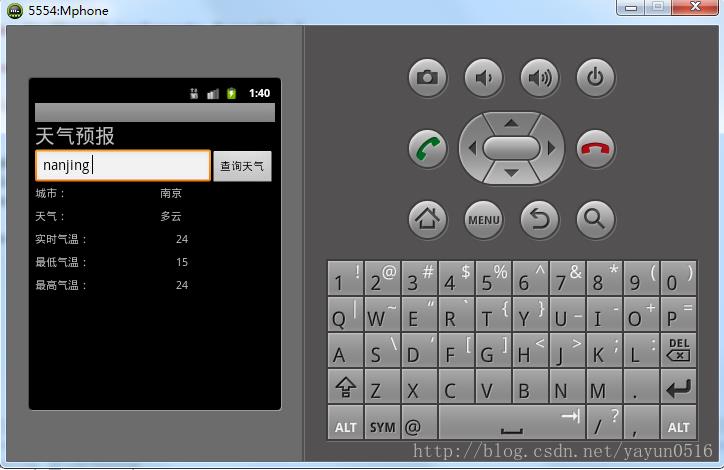Android MVVM Demo实战解析
Posted
tags:
篇首语:本文由小常识网(cha138.com)小编为大家整理,主要介绍了Android MVVM Demo实战解析相关的知识,希望对你有一定的参考价值。
参考技术A https://www.jianshu.com/p/996d76b2317fhttps://www.jianshu.com/p/fed20fc304b7
文章名称都懒得改,照搬过来了。
整体架构MVVM,网络请求用的retrofit2 + rxjava2,数据绑定使用的 databinding。
1.View层就是展示数据的,以及接收到用户的操作传递给viewModel层,通过dataBinding实现数据与view的单向绑定或双向绑定
2.Model层最重要的作用就是获取数据了,当然不止于此,model层将结果通过接口的形式传递给viewModel层
3.ViewModel 层通过调用model层获取数据,以及业务逻辑的处理。
2.LoginActivity
https://github.com/Ityang/mvvm-demo
Android实战--天气预报(API+JSON解析)
学习安卓有一段时间了,应该提高自己的实战能力,做一些简单的Demo。下面我们介绍一下如何利用网络API实现天气预报功能,主要涉及到如何利用API获得网络数据,网络数据返回一般是JSON格式,这里又涉及到JSON的解析问题,这些都是比较基础的问题,应该予以掌握。
首先在http://apistore.baidu.com/?qq-pf-to=pcqq.c2c找到你想要的API,这里我们选择http://apistore.baidu.com/astore/serviceinfo/1798.html,网页里有关于API的介绍:
接口地址:http://apistore.baidu.com/microservice/weather
请求方法:GET
请求参数:| 参数名 | 类型 | 必填 | 参数位置 | 描述 | 默认值 |
|---|---|---|---|---|---|
| citypinyin | string | 是 | urlParam | 城市拼音 | beijing |
http://apistore.baidu.com/microservice/weather?citypinyin=beijingJSON返回示例:
errNum: 0,
errMsg: "success",
retData:
city: "北京", //城市
pinyin: "beijing", //城市拼音
citycode: "101010100", //城市编码
date: "15-02-11", //日期
time: "11:00", //发布时间
postCode: "100000", //邮编
longitude: 116.391, //经度
latitude: 39.904, //维度
altitude: "33", //海拔
weather: "晴", //天气情况
temp: "10", //气温
l_tmp: "-4", //最低气温
h_tmp: "10", //最高气温
WD: "无持续风向", //风向
WS: "微风(<10m/h)", //风力
sunrise: "07:12", //日出时间
sunset: "17:44" //日落时间
下面搞一下布局文件:
<?xml version="1.0" encoding="utf-8"?>
<LinearLayout xmlns:android="http://schemas.android.com/apk/res/android"
android:layout_width="fill_parent"
android:layout_height="fill_parent"
android:orientation="vertical" >
<TextView
android:layout_width="wrap_content"
android:layout_height="wrap_content"
android:minHeight="30dp"
android:text="天气预报"
android:textSize="26dp" />
<LinearLayout
android:layout_width="fill_parent"
android:layout_height="wrap_content"
android:minHeight="30dp"
android:orientation="horizontal" >
<EditText
android:id="@+id/myedit"
android:layout_width="wrap_content"
android:layout_height="wrap_content"
android:layout_weight="1111" />
<Button
android:id="@+id/searchweather"
android:layout_width="wrap_content"
android:layout_height="wrap_content"
android:layout_weight="1"
android:text="查询天气 " />
</LinearLayout>
<LinearLayout
android:layout_width="fill_parent"
android:layout_height="wrap_content"
android:minHeight="30dp"
android:orientation="horizontal" >
<TextView
android:layout_width="wrap_content"
android:layout_height="wrap_content"
android:layout_weight="1"
android:text="城市:" />
<TextView
android:id="@+id/city"
android:layout_width="wrap_content"
android:layout_height="wrap_content"
android:layout_weight="1" />
</LinearLayout>
<LinearLayout
android:layout_width="fill_parent"
android:layout_height="wrap_content"
android:minHeight="30dp"
android:orientation="horizontal" >
<TextView
android:layout_width="wrap_content"
android:layout_height="wrap_content"
android:layout_weight="1"
android:text="天气:" />
<TextView
android:id="@+id/weather"
android:layout_width="wrap_content"
android:layout_height="wrap_content"
android:layout_weight="1" />
</LinearLayout>
<LinearLayout
android:layout_width="fill_parent"
android:layout_height="wrap_content"
android:minHeight="30dp"
android:orientation="horizontal" >
<TextView
android:layout_width="wrap_content"
android:layout_height="wrap_content"
android:layout_weight="1"
android:text="实时气温:" />
<TextView
android:id="@+id/temp"
android:layout_width="wrap_content"
android:layout_height="wrap_content"
android:layout_weight="1" />
</LinearLayout>
<LinearLayout
android:layout_width="fill_parent"
android:layout_height="wrap_content"
android:minHeight="30dp"
android:orientation="horizontal" >
<TextView
android:layout_width="wrap_content"
android:layout_height="wrap_content"
android:layout_weight="1"
android:text="最低气温:" />
<TextView
android:id="@+id/h_temp"
android:layout_width="wrap_content"
android:layout_height="wrap_content"
android:layout_weight="1" />
</LinearLayout>
<LinearLayout
android:layout_width="fill_parent"
android:layout_height="wrap_content"
android:minHeight="30dp"
android:orientation="horizontal" >
<TextView
android:layout_width="wrap_content"
android:layout_height="wrap_content"
android:layout_weight="1"
android:text="最高气温:" />
<TextView
android:id="@+id/l_temp"
android:layout_width="wrap_content"
android:layout_height="wrap_content"
android:layout_weight="1" />
</LinearLayout>
</LinearLayout>
下面连接工具类:
package org.lxh.demo;
import java.io.BufferedReader;
import java.io.IOException;
import java.io.InputStreamReader;
import java.net.HttpURLConnection;
import java.net.URL;
public class HttpDownloader
private URL url = null;
/**
* 根据URL下载文件,前提是这个文件当中的内容是文本,函数的返回值就是文本当中的内容 1.创建一个URL对象
* 2.通过URL对象,创建一个HttpURLConnection对象 3.得到InputStream 4.从InputStream当中读取数据
*
* @param urlStr
* @return
*/
public String download(String urlStr)
StringBuffer sb = new StringBuffer();
String line = null;
BufferedReader buffer = null;
try
url = new URL(urlStr);
HttpURLConnection urlConn = (HttpURLConnection) url
.openConnection();
urlConn.setRequestMethod("GET");
urlConn.setConnectTimeout(8000);
urlConn.setReadTimeout(8000);
buffer = new BufferedReader(new InputStreamReader(
urlConn.getInputStream()));
while ((line = buffer.readLine()) != null)
sb.append(line);
catch (Exception e)
e.printStackTrace();
finally
try
buffer.close();
catch (IOException e)
e.printStackTrace();
return sb.toString();
获取返回字符串之后要对此JSON数据进行解析:
package org.lxh.demo;
import java.util.ArrayList;
import java.util.HashMap;
import java.util.List;
import java.util.Map;
import org.json.JSONObject;
public class Util
public List<Map<String, Object>> getInformation(String jonString)
throws Exception
JSONObject jsonObject = new JSONObject(jonString);
JSONObject retData = jsonObject.getJSONObject("retData");
List<Map<String, Object>> all = new ArrayList<Map<String, Object>>();
Map<String, Object> map = new HashMap<String, Object>();
map.put("cityName", retData.optString("city"));
map.put("weather", retData.optString("weather"));
map.put("temp", retData.optString("temp"));
map.put("l_temp", retData.optString("l_tmp"));
map.put("h_temp", retData.optString("h_tmp"));
all.add(map);
return all;
下面Activity程序:
package org.lxh.demo;
import java.util.Iterator;
import java.util.List;
import java.util.Map;
import android.annotation.SuppressLint;
import android.app.Activity;
import android.app.ProgressDialog;
import android.os.Bundle;
import android.os.Handler;
import android.os.Message;
import android.util.Log;
import android.view.View;
import android.view.View.OnClickListener;
import android.widget.Button;
import android.widget.EditText;
import android.widget.TextView;
public class Main extends Activity
private EditText citynameEditText;
private Button searchWeatherButton;
private TextView citynametTextView;
private TextView weahterTextView;
private TextView tempTextView;
private TextView h_tempTextView;
private TextView l_tempTextView;
String jonString;
ProgressDialog progressDialog;
private static final int SET = 1;
@SuppressLint("HandlerLeak")
private Handler handler = new Handler()
@Override
public void handleMessage(Message msg)
switch (msg.what)
case SET:
Util util = new Util();
try
List<Map<String, Object>> all = util
.getInformation(msg.obj.toString());
Iterator<Map<String, Object>> iterator = all.iterator();
while (iterator.hasNext())
Map<String, Object> map = iterator.next();
Log.d("天气", map.get("weather").toString());
citynametTextView.setText(map.get("cityName")
.toString());
weahterTextView.setText(map.get("weather").toString());
tempTextView.setText(map.get("temp").toString());
h_tempTextView.setText(map.get("l_temp").toString());
l_tempTextView.setText(map.get("h_temp").toString());
catch (Exception e)
e.printStackTrace();
finally
break;
;
public void onCreate(Bundle savedInstanceState)
super.onCreate(savedInstanceState); // 生命周期方法
super.setContentView(R.layout.main); // 设置要使用的布局管理器
citynameEditText = (EditText) findViewById(R.id.myedit);
searchWeatherButton = (Button) findViewById(R.id.searchweather);
citynametTextView = (TextView) findViewById(R.id.city);
weahterTextView = (TextView) findViewById(R.id.weather);
tempTextView = (TextView) findViewById(R.id.temp);
h_tempTextView = (TextView) findViewById(R.id.h_temp);
l_tempTextView = (TextView) findViewById(R.id.l_temp);
searchWeatherButton.setOnClickListener(new OnClickListener()
public void onClick(View v)
new Thread(new NewThread()).start();
Log.d("按键", "Success");
);
private class NewThread implements Runnable
public void run()
String address = "http://apistore.baidu.com/microservice/weather?citypinyin="
+ citynameEditText.getText().toString();
HttpDownloader httpDownloader = new HttpDownloader();
String jonString = httpDownloader.download(address);
Message msg = Main.this.handler
.obtainMessage(Main.SET, jonString);
Main.this.handler.sendMessage(msg);
运行实例效果:

DEMO下载地址:http://download.csdn.net/detail/yayun0516/8705675
本例子只解析了几个数据作为例子,如有需要其他数据,可以自行添加,原理相同。发挥你的想象吧!
最后:
我的应用: http://openbox.mobilem.360.cn/index/d/sid/2966005
http://android.myapp.com/myapp/detail.htm?apkName=com.yayun.gitlearning
欢迎下载,有问题多交流!
以上是关于Android MVVM Demo实战解析的主要内容,如果未能解决你的问题,请参考以下文章
Android MVVM-编程思想2(入门实战MVVM,DataBinding,ViewModel,LiveData)
Android mvvm架构demo(DataBinding+LiveData+ViewModel+ Repository)
我应该如何在 Android 的 viewModel 中获取 Resources(R.string)(MVVM 和数据绑定)